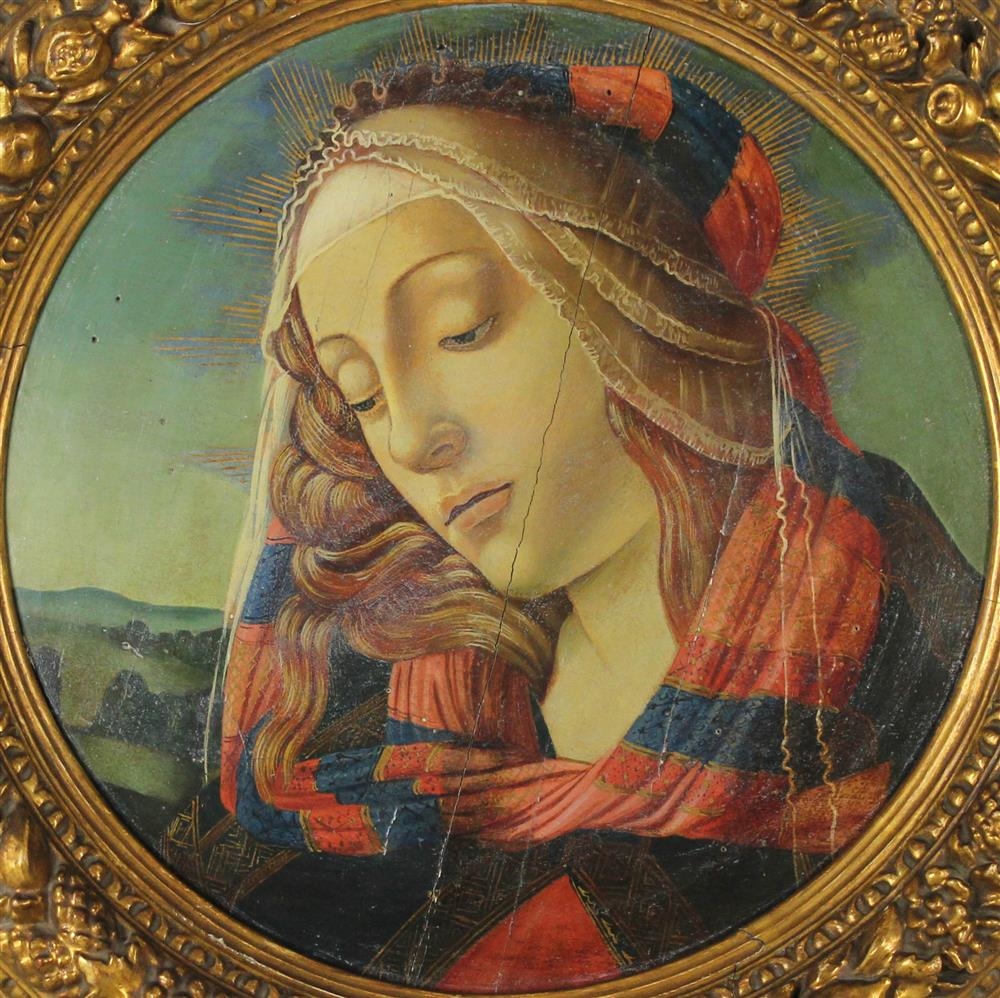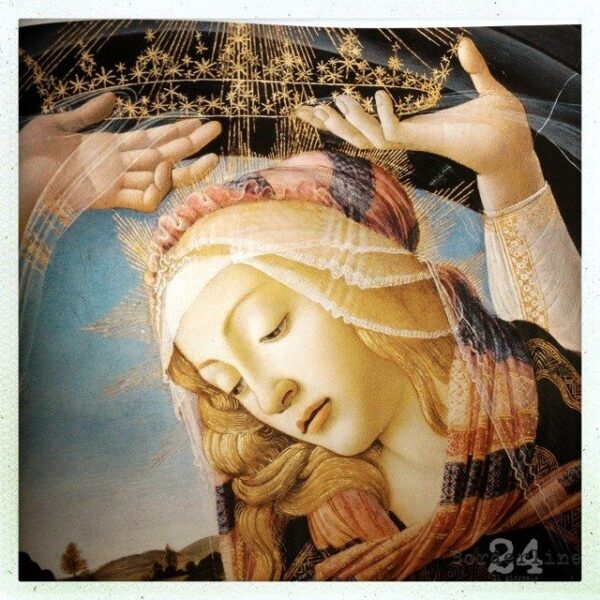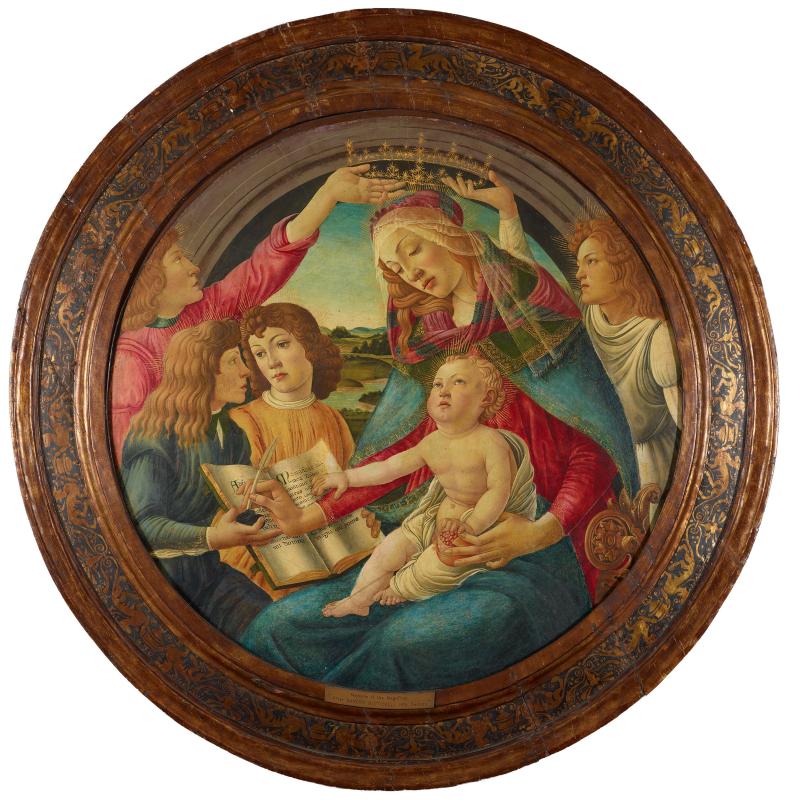
Madonna Del Magnificat Uffizi
La Madonna del Magnificat ( Madonna con il Bambino e cinque angeli) è un dipinto a tempera su tavola (diametro 118 cm) di Sandro Botticelli, databile al 1483 e conservato nella Galleria degli Uffizi di Firenze . Indice 1 Storia 2 Descrizione e stile 3 Note 4 Bibliografia 5 Voci correlate 6 Altri progetti 7 Collegamenti esterni Storia

Madonna of the Magnificat Sandro Botticelli Tokyo Gallery by Musee
118 cm (diameter) Inventory 1890 n. 1609 The Virgin Mary, crowned by two angels, is depicted on a throne. Under the guidance of her son, she is writing the canticle "Magnificat anima mea Dominum" (My soul doth magnify the Lord), which gives the painting its title. Jesus is sitting in his mother's lap.

Madonna of the Magnificat Botticelli, Web gallery of art, Sandro
The Magnificat, also known as The song of Mary, is the Virgin's prayer spoken to her cousin Elizabeth in the Gospel of Luke. When they met, St. John the Baptist, in the womb of Elizabeth, exults perceiving the presence of Christ in Mary's womb. Botticelli chose not to illustrate the biblical episode of the Visitation.
 - (MeisterDrucke-86052).jpg)
Madonna del Magnificat, 1482 (tempera sul pannello)
Botticelli created his Madonna del Magnificat in the 1481. At the time, it was his most famous picture of the Virgin. Botticelli has portrayed the Virgin writing, engaged in completing the final lines of a book held out towards her by two angels.

Madonna of the Magnificent by Botticelli, 1487 Sale artwork
Purchased for the Uffizi in 1784, this panel portrays the Madonna in the act of writing a prayer in a book with the Child and five angels. The particular r.

Botticelli Sandro MADONNA OF THE MAGNIFICAT MutualArt
Inv. 1912 n.178. The Madonna del Granduca is one of Raphael's most famous works and one of the images identified with the Palatine Gallery, the museum with the world's highest number of canvases and panels by the artist. It is one of Raphael's best-loved works, in which he shows all of his skill in representing holy subjects in an.

Stampa “Madonna del Magnificat (dettaglio)” di Sandro Botticelli
Our Lady of Altötting. Shrine of Our Lady of Altötting. The Shrine of Our Lady of Altötting, also known as the Chapel of Grace ( German: Gnadenkapelle ), is the national shrine of Bavaria dedicated to the Blessed Virgin Mary. It is known for the many healings which are said to have taken place there, and is commonly called the Lourdes of.

Sandro Botticelli Madonna del Magnificat 1481 Sandro botticelli
The Madonna of the Magnificat ( Italian: Madonna del Magnificat ), is a painting of circular or tondo form by the Italian Renaissance painter Sandro Botticelli. It is also referred to as the Virgin and Child with Five Angels. In the tondo, we see the Virgin Mary writing the Magnificat with her right hand, with a pomegranate in her left, as two.

Madonna of the Magnificat (Madonna del Magnificat) by BOTTICELLI, Sandro
This is an educational art history video exploring Sandro Botticelli's Madonna of the Magnificat as an introduction to his art. It examines Botticelli's art.

Madonna of the Magnificat posters & prints by Sandro Botticelli
Madonna del Magnificat di Sandro Botticelli prende il suo nome dal cantico che la Vergine sta scrivendo sul pesante libro sostenuto dagli angeli. Sandro Botticelli, Madonna del Magnificat, 1483-1485, tempera su tavola, diametro 115 cm. Firenze, Galleria degli Uffizi Qui trovi l'immagine dell'opera, vai al sito della del Museo Indice Descrizione

Madonna of the Magnificat z Painting by Sandro Botticelli
La Virgen del Magnificat (en italiano, Madonna del Magnificat, o también Madonna con il Bambino e cinque angeli) es un cuadro destacado del maestro renacentista Italiano Sandro Botticelli. Se conserva en la Galería de los Uffizi, de Florencia ( Italia ). Está realizado al temple sobre tabla.

La Madonna del Magnificat e la sublime bellezza di Sandro Botticelli
The Madonna of the Magnificat ( Italian: Madonna del Magnificat ), is a painting of circular or tondo form by the Italian Renaissance painter Sandro Botticelli. It is also referred to as the Virgin and Child with Five Angels.

Madonna of the Magnificat The Library & Museum
Race, religion and the Black Madonna. Found in hundreds of Catholic churches across Europe and Latin America, the Black Madonna, a depiction of the Virgin Mary with dark skin, remains one of the most mysterious and controversial religious icons. She has a complex history and many possible meanings. Words by Daniela Vascoaverage reading time 6.

La Madonna del Magnificat di Botticelli Arte Svelata
La Madonna del Magnificat è un dipinto realizzato dal grande pittore rinascimentale Sandro Botticelli (1445-1510) intorno al 1481, quindi poco prima di recarsi a Roma per realizzare alcuni affreschi della Cappella Sistina. Leggi anche: Da Filippo Lippi a Botticelli: la fortuna della "lippina" Sandro Botticelli, Madonna del Magnificat, 1481.
.jpg)
Madonna del Magnificat, c.1483 1485 Sandro Botticelli
Madonna col Bambino e angeli (Madonna del Magnificat) Sandro Botticelli (Firenze 1445 -1510) Caratteristiche Descrizione Video Ipervisioni Data 1483 c. Museo Gli Uffizi Collezione Pittura Collocazione Sala 10-14 Tecnica Tempera su tavola Dimensioni 118 cm (diametro) Inventario 1890 n. 1609
Sandro Botticelli, Madonna del Magnificat (1481) Galleria degli
Many Black Madonnas are venerated in places that were sanctified by a sacred tree or appeared in a tree.¹ To this day several centuries old "Marienlinden" (Mary-linden-trees) are venerated in Germany and Austria.². Our Dear Lady of Altötting was carved of linden wood and a guide to the town speaks of a venerable, ancient linden tree that.